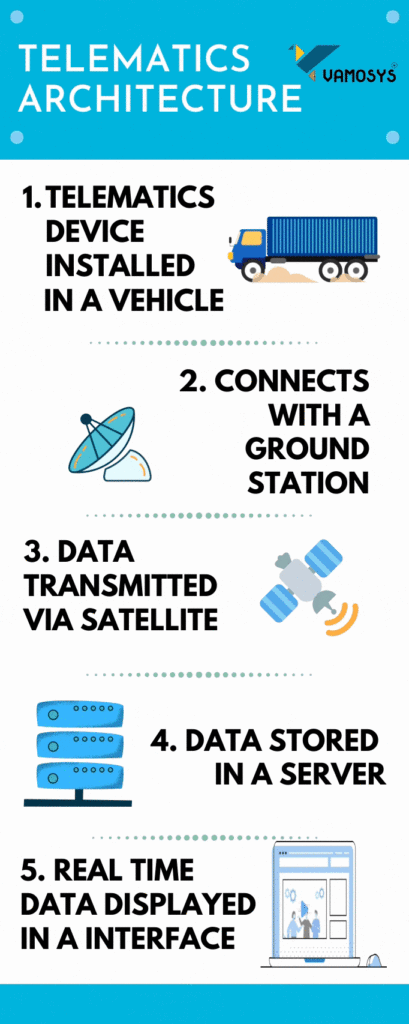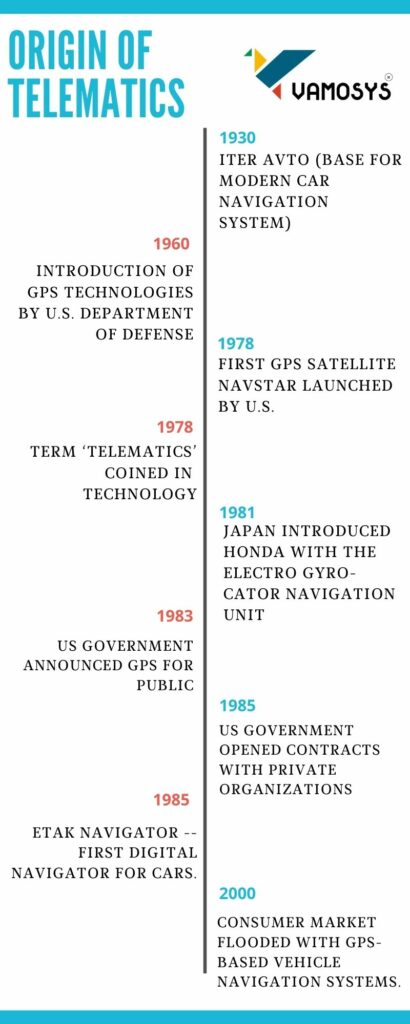What is Telematics?
It is a new age technology used to monitor assets like cars, trucks, planes, heavy equipment including ships. With the use of telematics technology, we can capture, analyze, and diagnose the data of our assets. Here, in this article, you will get to know all the information and knowledge of telematics.
What is Telematics?
Telematics is a combination of telecommunication and informatics. Telematics is an intelligent vehicle technology. It was mainly introduced to overcome problems faced in road safety, transportation issues, fleet management problems, etc,. Telematics will enable you to share the captured information from small telematic devices applied with wireless technology. Telematics devices are also called black-box devices.
Telematics Data Transmission Architecture
Components Required for Telematics transmission Process
- Telematic device or Telematics control unit.
- SIM card.
- Receiver or user interface application.
How does Telematics Solutions work?
- The telematics control unit needs to be installed in a vehicle or an asset to collect the data.
- The telematics control unit collects the data from vehicle sensors.
- The telematics control unit will manage the data and connect it to a cellular network or a ground station where it can convert the data into a signal form. The data transmission and location tracking happen through a network of cellular towers and satellite systems.
- The converted data was transmitted to a cloud server with the help of the Satellite.
- A user interface application can access the data from the cloud server.
Telematics and Automotive Industry
Automotive is the industry related to or concerned with motor vehicles. A wide range of organizations undertakes overall control like designing, manufacturing, marketing, selling of motor vehicles.
Telematics in the automotive industry is the combination of telecommunication and motor vehicle informatics applied with wireless technology. Vehicle telematics or telematics in the automotive industry, later on, referred to as automation in the automobile industry.
Vehicle telematics addresses and enhances the intelligent transportation system which can help to improve the productivity of an organization.
Telematics and IoT
The Internet of things is the extension of internet/network connectivity to physical devices. Those physical devices are embedded with sensors, communicative hardware which helps to collect and send real-time data.
When IoT and telematics combine they provide connectivity to interact, communicate between physical devices. IoT also provides Cloud Infrastructure and Internet Connectivity to a vehicle or an asset where it was installed.
Features offered by Telematics System
- Complete fleet management.
- Cloud Infrastructure
- Safety
- Security
- Internet Connectivity
Let’s see a detailed picture of telematics benefit in the upcoming topic.
History / Origin of Telematics
Telematics was born in the 1960s when the U.S. Department of Defense and Johns Hopkins University’s Applied Physics Laboratory began developing the Global Positioning System (GPS).
1930: Iter Avto (Base for modern car navigation system) — map guidance tool. A device with paper maps works without satellites.
1960: Introduction of GPS technologies by the U.S. Department of Defense and Johns Hopkins University’s Applied Physics Laboratory began developing the Global Positioning System (GPS).
1978: The first GPS satellite NAVSTAR was launched by the US—“Navigation System with Timing and Ranging”.
The term ‘Telematics’ coined in the technology development report to the French prime minister.
1981: Japan introduced Honda with the Electro Gyro-Cator navigation unit for the public. Which uses translucent maps placed manually inside the screen
1983: US government announced GPS for the public to improve safety navigation and increase safety for air traffic.
1985: US government opened contracts with private organizations to create portable GPS devices.
1985: Etak navigator — first digital navigator for cars.
1988: Major EEC research programs launched to experiment with vehicle telematics with the objective of improving road safety and reducing environmental impact.
1996: GPS made as an international utility where private citizens and businesses can use GPS for free of cost.
2000: Consumer market flooded with GPS-based vehicle navigation systems.
Late 2000’s: Advancements in cloud and Machine-to-Machine (M2M) technologies enable super-fast and precise tracking of GPS data and other sensor parameters accessible for real-time reporting.
Present: Unprecedented innovation in the Internet of Things (IoT) and M2M based telematics data management capabilities for the enterprise and consumer market.
Telematics Device Architecture
A telematics control unit has below mentioned elements in it
- GPS control unit — which keeps track of the vehicle.
- Data Transmission (SIM card) — which will connect cellular networks and satellites and helps for data transmission.
- Communication — Wifi or LTE, for an Internet connection.
- an electronic processing unit;
- Memory space — store information about the vehicle’s sensor data.
- Battery — Supply electric power to the device
How Telematics Devices are Installed
In this present situation, GPS tracking and telematics technology are approaching us as an in-built device in a vehicle. If there is no in-built GPS and telematics technology in a vehicle; there are lots of telematics devices available in the market, which a user can install separately in the vehicle.
Familiar names like Italon, Concox, Iota, cantrack sensors are installed in a vehicle for different purposes like fuel monitoring, temperature monitoring, location tracking, etc,. These all sensors for different purposes are presented by Vamo Systems in addition, we also provide 24*7 customer support and installation of the sensors to the vehicles. Here is the place where a user can get a complete solution for their fleet vehicles.
Benefits of Telematics
Telematics helps a fleet organization to achieve better productivity by lowering the operational cost. Let’s see the benefits of the telematics feature.
1. Provides Complete Fleet Management
Telematics devices are compatible with entire types of motor vehicles. These devices are mainly used in the transportation and logistics Industry. Telematics technology provides the complete solution which users face in their fleet organization.
Fuel level Monitoring
Fuel monitoring and controlling is a method where one-third amount of operational costs can be minimized in a fleet management organization. Fuel Monitoring can be done by fuel level sensors. Where those sensors are installed inside the fuel tank. Conditions for those sensors can be customized. For example, a user can lay conditions as alert via message when fuel reaches half tank or notify the user when the fuel left only 1ltr. These conditions can be given by the users according to their needs.
When it comes to Vamo Systems we use, Italon fuel sensor for accuracy and durability. Where our clients can customize their conditions according to their needs. Also, we provide double tank fuel sensors and double the length of fuel sensors. In double tank fuel sensors, 2 fuel sensors are installed in different tanks and we provide combined monitoring for a vehicle. If the length of the fuel tank is deeper we do provide a solution for that. In this case, fuel 2 fuel sensors are combined and monitored.
Speed Management
Common vehicle speed limits will depend upon the type of the road, but the speed of your vehicle depends upon the driver. If your vehicle is in the right hands you can save your vehicle. So, speed management becomes the main factor to monitor.
There are several benefits of speed management like driver’s safety, Fuel control, and vehicle performance level.
Considering the driver’s safety in a fleet organization can lower the death, accidental rate, and even vehicle repair cost. By maintaining a constant speed can improve vehicle performance and reduce downtime. Even fuel can be controlled by speed management, minimum speed can give a vehicle better mileage.
Vehicle Health Report
Telematics technology makes it easy to diagnose a vehicle’s performance. Regular vehicle health reports and scheduling maintenance according to the diagnostic report can help a fleet manager to reduce the downtime or unplanned sudden repairs of the vehicle.
Vehicle health check reports will guide a user to make decisions over vehicle performance level and vehicle acquisition.
Route Navigation
Route navigation works on the shortest path algorithm to provide the best possible short route. Navigation is a way to control fuel usage and time management. Where these both factors will lead to saving excess operational cost and customer satisfaction.
Telematics system provides better visibility and makes the fleet more efficient.
2. Cloud Infrastructure
Cloud is basically a large distribution network for memory and data storage. Cloud Infrastructure is a term that describes the components to build a cloud. Cloud infrastructure is a tool, which helps to run an application or a service in the cloud.
The combination of vehicle information and data transmission over a network is said to be telematics. That information is stored and retrieved in an application with the help of the cloud. Cloud in telematics provides a strong backend for the telematics application.
How does a cloud infrastructure work with a vehicle?
If telematics technology connects a vehicle with a cloud will help a driver to provide automatic notification to the concerned organization via the telematics application used. This process can be enabled in case of an accident.
Telematics and cloud went beyond driver safety and makes the fleet more efficient like emergency and crisis assistance, providing camera systems, voice assistance, automatic crash notifications, even driver behavior reports, etc,.
3. Safety and Security
Telematics provides features such as remote door lock/ unlock activity indications to the driver and the main usage is to notify vehicle theft.
Stolen vehicle tracking is a challenging task without telematics technology. A telematics device can exactly point out the location of the stolen vehicle. Once the vehicle engine stops automatically alerts are sent to the concerned organization via SMS or calls.
Telematics may not stop the initial theft but telematics help to find out the stolen vehicle in an easier way.
More than location and safety information, telematics devices help a user in all ways to solve fleet problems like it captures harsh braking, speed, idle time of the vehicle even temperature monitoring.
Functions of Telematics Solution
A black box sort of device, which is hard fitted into the car, is probably the best-known way of capturing this data. But other options are available, like, there are mobile apps that can be used for telematics or you can plug devices into the lighter socket or other ports in your car. Increasingly they’re coming fitted as standard devices in a vehicle. They capture quite a bit of data which is useful not only for insurance companies but for drivers too with telematics-based insurance. For example, you can get a custom dashboard, where you can track your journeys and driving scores, also you can get feedback to help make your driving safer. This in turn will hopefully help lower your prices further, everyone wins.
There is a great deal of scope for other useful functions. Your device could alert emergency services if you’re in a serious accident at an instance. The other way would be, to send diagnostic data to a breakdown recovery service if you pass out it. This could be used to automate toll payments. The ways in which telematics could ultimately help drivers are limitless.
Telematics and Fleet Management
Fleet management companies usually help and monitor vehicles such as trucks, cars, buses and ships, etc. The duties such as, fuel management, keep a track on vehicle’s health, driver’s management and much more eventually aiming to reduce risks and costs of the business. Telematics play a key role in helping to fulfill the above demands for a better productivity and improve efficiency of the service, eventually the product itself.
The Future of Telematics
Around the world, the automobile industry is combining and installing telematic technology in their vehicles. This is to keep an eye on the performance of their vehicles, which in turn help in improving their performance and understanding their customers better. In the developed nations of Western Europe and North America, the usage and dependency is set to cross the 80% mark within the first quarter of 2019. In the developing regions of world, the usage telematics technology is experiencing a rapid growth as well. In consonance with statista.com, which shows the forecast of telematics market and as of 2020, it is projected to up its value to $2.2 billion.
Telematics technology is not a recent feature in the automotive industry. Previously telematics technology was just a lesser-known tool but now it has become a essential feature in the transportation and logistics industry..
Telematics is mainly used in business sectors like transportation and the logistics industry.
If you want to implement telematics in your business, first you need to identify and know more about your business and need to follow specific business modules and applications.
A good telematics system will provide you a better view of both driver and vehicle performance.
Using telematics technology brings benefits to an organization in all ways and we sell benefits to you, more than our products!



